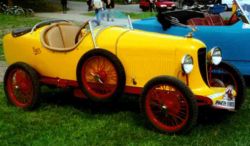| Amilcar CGS | |
|---|---|
 1925 Amilcar CGS | |
| Overview | |
| Manufacturer | Amilcar |
| Production | 1923–1925 |
| Body and chassis | |
| Related | Amilcar CGSS |
| Powertrain | |
| Engine | 1,074 cc four cylinder |
| Transmission | Three speed manual |
| Dimensions | |
| Wheelbase | 96.5 in (2,450 mm) |
| Length | 134 in (3,400 mm) |
The Amilcar CGS Grand Sport was a popular inter war lightweight sports car, manufactured by the French automobile maker Amilcar between 1923 and 1925. A response to the successful Salmson VAL3 series, the "C Grand Sport" was developed from the Amilcar C. [1] The CGS had a longer, more rigid chassis, and improved brakes in addition to its bigger engine.
Contents

Its 1,074cc, 30 bhp, side valve engine with an aluminium head gave it a listed top speed of at least 120 km/h (75 mph), and could be tuned for better performance. Four-wheel brakes were fitted. [1]
A lowered and higher tuned version, the CGSS, the second S standing for surbaisse (lowered), was also made. Around 4,700 of both types were made. [1]